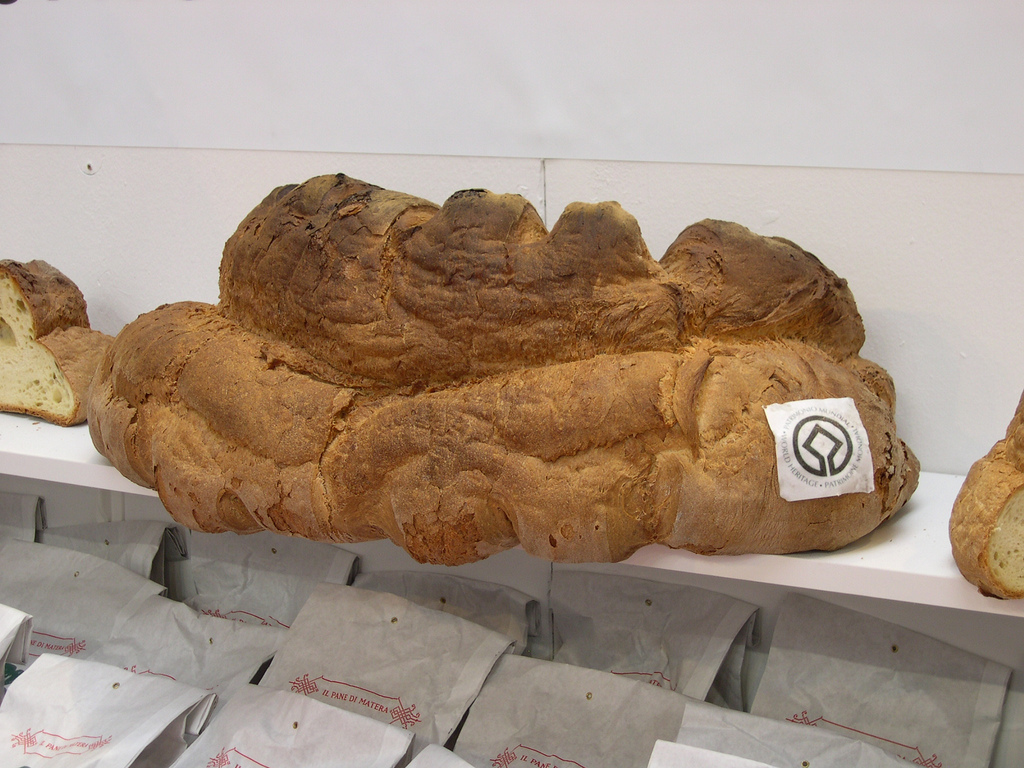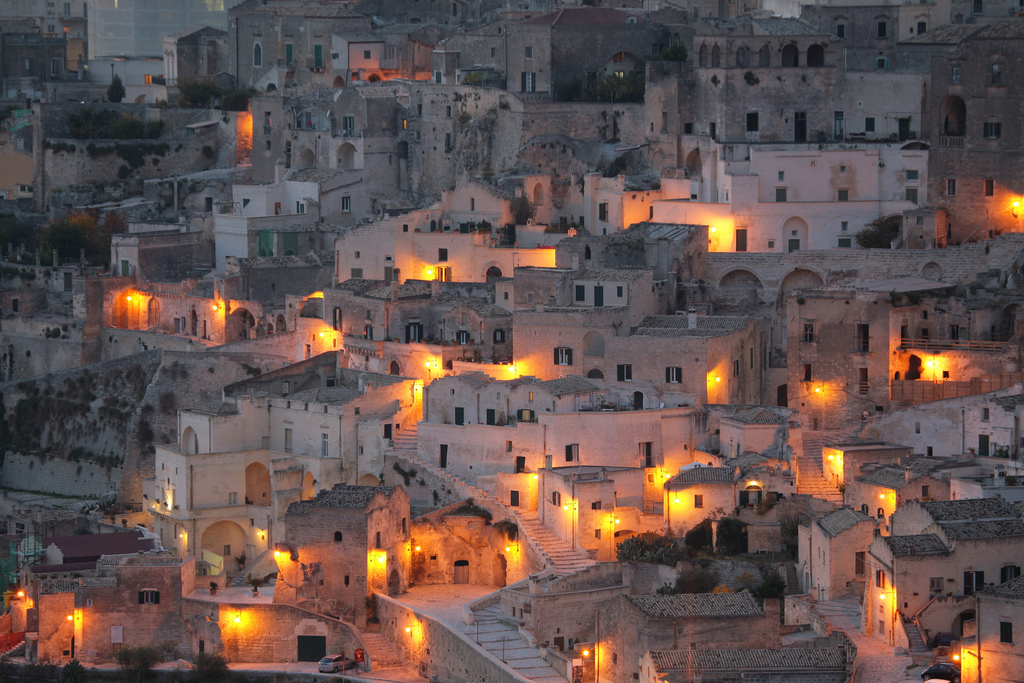 Yeast base, durum wheat flour, salt, and water. Prepared with natural local products for millennia. The bread of Matera can be defined as an archaeological product of Mediterranean alimentary tradition. Its excellent and unforgettable flavour, scent, brown colour of crust and pale yellow of crumb allowed this regional product in the earth of Southern Italy to emerge in comparison with the big and diversified production of Italian breads. It is an extraordinary bread with salt cheeses and omelettes, as well as for sweet breakfasts, with honey and jams. Another feature that makes it unique in the outline of Southern Italy bread-making is its conical shape, that reminds the mysterious and harsh mountains of Murgia, that cross the province of Matera. The secret of its flavour and long preservation consists in the special preparation of yeast base, made with spring water and fresh fruit put to macerate. The so obtained yeast is then used several times.
Yeast base, durum wheat flour, salt, and water. Prepared with natural local products for millennia. The bread of Matera can be defined as an archaeological product of Mediterranean alimentary tradition. Its excellent and unforgettable flavour, scent, brown colour of crust and pale yellow of crumb allowed this regional product in the earth of Southern Italy to emerge in comparison with the big and diversified production of Italian breads. It is an extraordinary bread with salt cheeses and omelettes, as well as for sweet breakfasts, with honey and jams. Another feature that makes it unique in the outline of Southern Italy bread-making is its conical shape, that reminds the mysterious and harsh mountains of Murgia, that cross the province of Matera. The secret of its flavour and long preservation consists in the special preparation of yeast base, made with spring water and fresh fruit put to macerate. The so obtained yeast is then used several times.
The choice of ancient typologies of wheats, that still have in their genetic code some features that are not present in other ones, allows to obtain flours that give to the bread its unique flavour. It is a symbol of flavour of the land of Matera and its measureless and attracting cornfields, that are a fertile golden desert among Irpinia, Foggia, and Lucania. Not so known lands, because they are not on the sea, but surrounded and crossed by steep mountains. A Southern Italy that allows to see many towns and little countries, that in the past were depopulated by emigration and now live again, thanks to such agricultural and alimentary excellences as the bread of Matera. A bread that is famous also thanks to the important advertising made by the inhabitants of this region dispersed all over the world, especially in USA, Germany, and Australia. The bread of Matera is well recognizable thanks to its flavour and scent as well as characteristic bubbles due to its slow leavening and cooked on a log-fire. A bread that, thanks to the use of yeast base and superfine flour coming from wheats of the varieties Duro Lucano, Capeiti, Appulo, keeps from 7 to 9 days. A very ancient search for the most suitable wheats, use of durum wheat flour, that is generally used for producing pasta, give to this bread an intense and dense flavour, as well as long preservation. The loss of water that occurs during the following days make this bread even more tasty.
A true work of art
 According to legends that have been handed on for centuries, in this isolated land of a touching beauty, the air, too, makes its contribution to this bread characterized by a singular shape and unforgettable flavour. Up to now the working of these breads is made among the ‘Sassi of Matera’, world property of Unesco, an unparalleled example in the world of rupestrian settlement. A town that was completely obtained in the rock, a body of superimposed caves that represent a work of art. Hundreds of thousands of artists took part to its realization, with the same aim: living on what nature offered to them. The manufacture of bread is made in three times and each family books the day before the most suitable time for them. In the past, the bookings were made thanks to a helper of the oven, who wandered through the steep streets of Sassi and with his whistle announced the production at 6:00, 8:00, and finally 10:00 o’clock in the morning. A virtuous example of how technology allowed to change a local manufacturing in a production that aims at export, thanks to long preservation of this bread. Technology did not distort the ancient manufacturing method; on the contrary, it faithfully reproduced the typical fist kneading by means of machines. So, the bread of Sassi of Matera, made with wheat that is used for manufacturing pasta, won the whole world with its flavour.
According to legends that have been handed on for centuries, in this isolated land of a touching beauty, the air, too, makes its contribution to this bread characterized by a singular shape and unforgettable flavour. Up to now the working of these breads is made among the ‘Sassi of Matera’, world property of Unesco, an unparalleled example in the world of rupestrian settlement. A town that was completely obtained in the rock, a body of superimposed caves that represent a work of art. Hundreds of thousands of artists took part to its realization, with the same aim: living on what nature offered to them. The manufacture of bread is made in three times and each family books the day before the most suitable time for them. In the past, the bookings were made thanks to a helper of the oven, who wandered through the steep streets of Sassi and with his whistle announced the production at 6:00, 8:00, and finally 10:00 o’clock in the morning. A virtuous example of how technology allowed to change a local manufacturing in a production that aims at export, thanks to long preservation of this bread. Technology did not distort the ancient manufacturing method; on the contrary, it faithfully reproduced the typical fist kneading by means of machines. So, the bread of Sassi of Matera, made with wheat that is used for manufacturing pasta, won the whole world with its flavour.
A special shape, long preservation: no big strategies are needed in order to present itself. On the contrary, as it often happens for these baked products, the best things occurs when the consumer has in his (or her) hands such a fragrant and scented bread. Its flavour and softness are preserved in special plastics for bread, that allow the product to transpire. The labels used in the different ovens of Matera remind the presence of wheat in both their symbols and colours. There are also geographical references to the land of Matera and, of course, Sassi.

